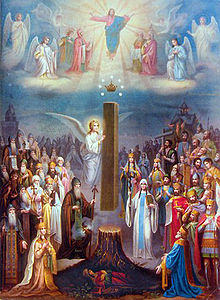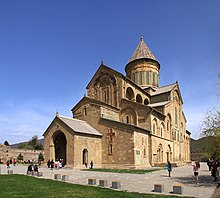Svetitskhoveli Cathedral
The Svetitskhoveli Cathedral ( Georgian სვეტიცხოვლის საკათედრო ტაძარი, "Cathedral of the Life-Giving Pillar") is a church in Georgia . It is located in the city of Mtskheta , 20 kilometers from the Georgian capital Tbilisi . With other historical monuments in Mtskheta, it is a UNESCO World Heritage Site .
overview
For several centuries the cathedral was the coronation and burial church of the Georgian monarchs and at the same time the main church of the Georgian Orthodox Apostle Church . Today it is the seat of the Archbishop of Mtskheta and Tbilisi, who is also the Catholicos Patriarch of Georgia. It is the second largest Georgian church after the Trinity Cathedral in Tbilisi.
The cathedral was built from 1010 to 1029 by the Georgian architect Arsakidze. A church stood in its place as early as the 4th century. It was the first church in Georgia and was built under the rule of the Iberian King Mirian III. built. Legends about the Christianization of Georgia in 317 surround the previous building .
Legend

It is said that Saint Nino chose the confluence of the Kura and Aragwi as the place for the first church in Georgia, drawing on an ancient narrative.
Then a Georgian Jew named Elias from Mtskheta traveled to Jerusalem to speak for him in the trial against Christ. But he came too late, only saw the crucifixion. On the hill of Golgotha he is said to have bought the robe of a Roman soldier and brought it to Georgia. At home in Mtskheta, his sister Sidonia hugged it and died immediately. Because the robe could not be torn from its grip, she was buried with him. A huge cedar would later grow on her grave .
Saint Nino is said to have ordered the cedar to be felled and the church to be built over the grave. A column for the church building was to be made from the cedar wood. But the column could not be raised. Nino is said to have prayed all night, then an angel appeared in a bright light who raised his arms. Then the column stood up, sank to the ground and the construction could be completed. Later, the cedar column is said to have produced a sacred liquid that could cure people of all diseases.
The legend gave the cathedral its name: Sweti tskhoveli means "life-giving column". The mythical symbolism of the heavenly column has its parallel in the miraculous foundation of the Armenian cathedral of Etchmiadzin by St. Gregory , as it is narrated by Agathangelus .
The place of the tomb of Sidonia is marked in the cathedral. A picture by Michail Sabinin to the right of the cathedral entrance shows the floating seventh column: Sidonia and an angel lift it into heaven. In the foreground is Saint Nino with King Mirian III. on her right, his wife Nana on her left, behind them numerous saints of Georgia, above in the open sky Christ in a halo.
history
The church building has been destroyed and rebuilt several times since the 4th century, especially after the invasions of the Arabs , Persians and the Mongolian conqueror Timur Langs . Even earthquakes translated to the building. When the cathedral was restored in 1970 and 1971 , the foundations of a basilica were found in it . It was built in the late 5th century by King Vakhtang I Gorgassali in place of the first church built by Saint Nino.
The current cathedral was built in the 11th century at the instigation of the Georgian Catholicos Melkizedek under the rule of King Giorgi II . In 1787 , under King Irakli II , it was surrounded by a five-meter-high stone and brick wall. Its top floor served military purposes and was reinforced with battlements . The wall had eight towers, six of them cylindrical and two square. There was an entrance to the south.
In 1963 , during archaeological excavations on the south wall, a residential building belonging to the Catholicos from the 11th century was found. The remains of a two-story castle for Patriarch Anton II were found within the enclosure.
architecture
basilica
The destroyed basilica from the 5th century was a small three-aisled church almost square in shape.
Cross-domed church
The building from the 11th century that has been preserved to this day is a modern cross-domed church . The architectural style was after the unification of Georgia under Bagrat III. ( 978 - 1014 ) dominate for church buildings. It is characteristic that the dome covers all four sides of the church. The statics should give the church good acoustics . The dome has been reconstructed several times since the 11th century.
The cathedral was built from yellow sandstone . The facade shows reliefs, including peacock ornaments whose stylized tail feathers symbolize the apostles , bulls' heads , birds, grapevines and St. George . Red stone was used for the windows of the apse . The green stone used in the cylinder of the dome dates from the 17th century .
The western end of the cathedral is covered by a large window. It shows Christ with angels on either side. The sculpture on the wall is no longer the original. It was restored several times after being destroyed, most recently in the 19th century .
Architect Arsukidze
A relief on the outer north wall of the cathedral is shrouded in legend. It shows a right arm holding a chisel , the symbol of stonemasons . An inscription reads: “May the hand of Arsukidze, servant of God, be forgiven him.” An inscription on the east wall is said to prove that the architect did not live to see the completion of his building: “This holy church was created by the hand of his wretched servant Arsukidze built. May his soul find peace, oh master. "
The poet Konstantine Gamsachurdia took up this legend in his novel The Hand of the Great Master . He wrote that a royal vizier who had taught Ardsukidze the art of building had become so jealous of his pupil at the sight of the building that he used his influence on the king to have his right hand cut off.
Icons and frescoes
The interior walls of the cathedral are painted with frescoes , but these are no longer in their original state. In 1830 all of them were whitewashed on the occasion of a visit by the Russian Tsar Nicholas I. A few have since been restored, including the apocalyptic beasts from the 13th century and depictions of the signs of the zodiac .
The icons on the walls are not originals, but copies. The originals hang in the state museums. The large painting of Christ on the altar was made by a 19th century Russian artist.
Baptismal font
To the right of the cathedral entrance is a stone baptismal font from the 4th century. It is said that when Christianity was introduced into Georgia, King Mirian III was baptized. and served his wife Nana.
literature
- Shalva Amiranashvili: History of Georgian Art . Khelovneba, Tbilisi 1961
- Roger Rosen: Georgia: A Sovereign Country of the Caucasus . Odyssey Publications, Hong Kong 1999, ISBN 962-217-502-3
- Натроев А. Мцхет и его собор Свэти-Цховели. Историко-археологическое описание. 1900
Web links
Coordinates: 41 ° 50 ′ 31.5 " N , 44 ° 43 ′ 15.8" E



